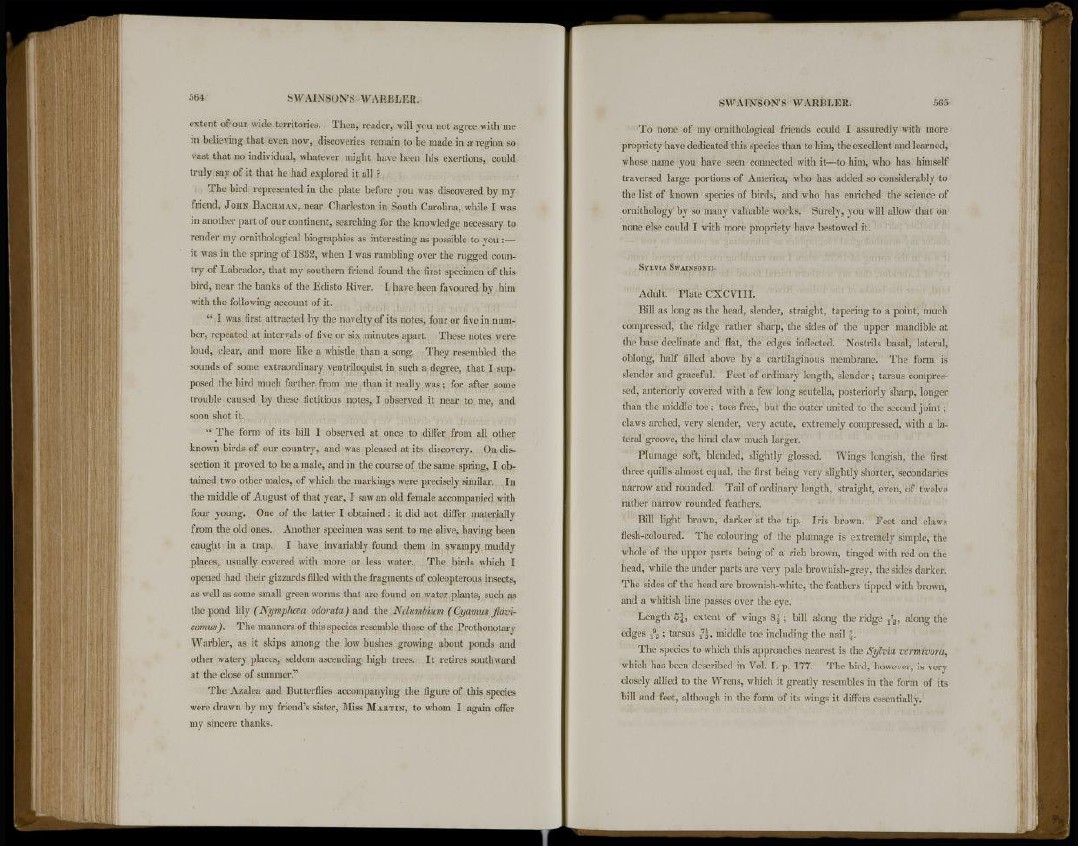
564 SWAINSON'S WARBLER.
extent of our wide territories. Then, reader, will you not agree with me
in believing that even now, discoveries remain to be made in a* region so
vast that no individual, whatever might have been his exertions, could
truly say of it that he had explored it all ?
The bird represented in the plate before you was discovered by my
friend, JOHN BACHMAN, near Charleston in South Carolina, while I was
in another part of our continent, searching for the knowledge necessary to
render my ornithological biographies as interesting as possible to you :—
it was in the spring of 1832, when I was rambling over the rugged country
of Labrador, that my southern friend found the first specimen of this
bird, near the banks of the Edisto River. I have been favoured by him
with the following account of it.
" I was first attracted by the novelty of its notes, four or five in number,
repeated at intervals of five or six minutes apart. These notes were
loud, clear, and more like a whistle than a song. They resembled the
sounds of some extraordinary ventriloquist in such a degree, that I supposed
the bird much farther from me than it really was; for after some
trouble caused by these fictitious notes, I observed it near to me, and
soon shot it.
" The form of its bill I observed at once to differ from all other
known birds of our country, and was pleased at its discovery. On dissection
it proved to be a male, and in the course of the same spring, I obtained
two other males, of which the markings were precisely similar. In
the middle of August of that year, I saw an old female accompanied with
four young. One of the latter I obtained: it did not differ materially
from the old ones. Another specimen was sent to me alive, having been
caught in a trap. I have invariably found them in swampy muddy
places, usually covered with more or less water. The birds which I
opened had their gizzards filled with the fragments of coleopterous insects,
as well as some small green worms that are found on water plants, such as
the pond lily (Nymphcea odorata) and the Nclumbium (Cyamus jlavicomus).
The manners of this species resemble those of the Prothonotary
Warbler, as it skips among the low bushes growing about ponds and
other watery places, seldom ascending high trees. It retires southward
at the close of summer.'"
The Azalea and Butterflies accompanying the figure of this species
were drawn by my friend's sister, Miss MARTIN, to whom I again offer
my sincere thanks.
SWAINSON'S WARBLER. 565
To none of my ornithological friends could I assuredly with more
propriety have dedicated this species than to him, the excellent and learned,
whose name you have seen connected with it—to him, who has himself
traversed large portions of America, who has added so considerably to
the list of known species of birds, and who has enriched the science of
ornithology by so many valuable works. Surely, you will allow that on
none else could I with more propriety have bestowed it.
SYLVIA SWAINSONII.
Adult. Plate CXCVIII.
Bill as long as the head, slender, straight, tapering to a point, much
compressed, the ridge rather sharp, the sides of the upper mandible at
the base declinate and flat, the edges inflected. Nostrils basal, lateral,
oblong, half filled above by a cartilaginous membrane. The form is
slender and graceful. Feet of ordinary length, slender ; tarsus compressed,
anteriorly covered with a few long scutella, posteriorly sharp, longer
than the middle toe; toes free, but the outer united to the second joint;
claws arched, very slender, very acute, extremely compressed, with a lateral
groove, the hind claw much larger.
Plumage soft, blended, slightly glossed. Wings longish, the first
three quills almost equal, the first being very slightly shorter, secondaries
narrow and rounded. Tail of ordinary length, straight, even, of twelve
rather narrow rounded feathers.
Bill light brown, darker at the tip. Iris brown. Feet and claws
flesh-coloured. The colouring of the plumage is extremely simple, the
whole of the upper parts being of a rich brown, tinged with red on the
head, while the under parts are very pale brownish-grey, the sides darker.
The sides of the head are brownish-white, the feathers tipped with brown,
and a whitish line passes over the eye.
Length 5\, extent of wings 8£ ; bill along the ridge T
7
Z , along the
edges ft; tarsus T
7 | , middle toe including the nail | .
The species to which this approaches nearest is the Sylvia vcrmivora,
which has been described in Vol. I. p. 177. The bird, however, is very
closely allied to the Wrens, which it greatly resembles in the form of its
bill and feet, although in the form of its wings it differs essentially.